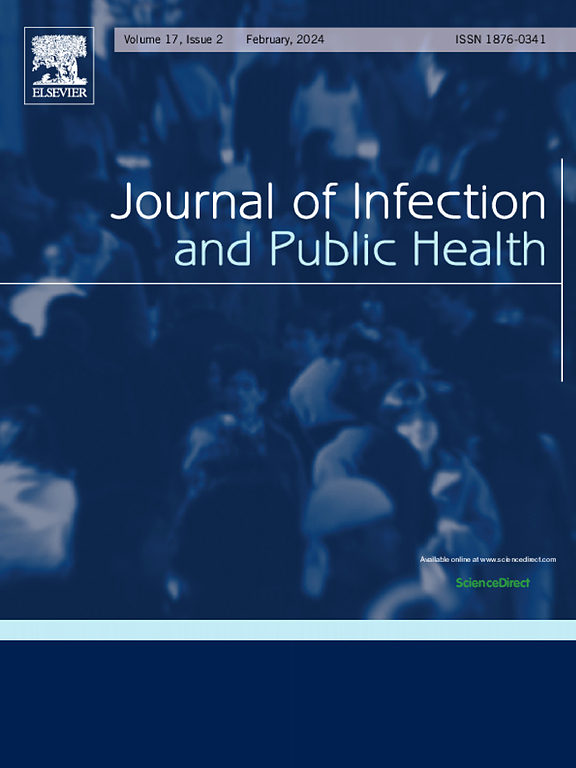产后出血是妊娠期母体SARS-CoV-2组粒变异感染激增的关键结果
IF 4.7
3区 医学
Q1 INFECTIOUS DISEASES
引用次数: 0
摘要
尽管有证据表明疾病严重程度随着病毒的演变和疫苗接种的努力而变化,但在不同妊娠期,孕产妇、围产期和新生儿结局与SARS-CoV-2感染之间的联系仍不清楚,特别是在2022年12月中国BA.5和BF.7欧米克隆亚变体激增的情况下。本研究调查了不同妊娠期孕产妇、围产期和新生儿结局与SARS-CoV-2感染之间的相关性。方法本前瞻性队列研究在中国西南地区的两家医院进行,研究了2022年1月1日至2023年9月30日期间登记的2158名孕妇的临床记录和感染状况。最初不受COVID-19的影响,人口后来经历了显著的感染激增。一项比较分析评估了感染和未感染受试者之间的孕产妇、围产期和新生儿结局。主要结局包括妊娠并发症和早产,次要结局包括剖宫产、分娩并发症和新生儿结局。结果感染SARS-CoV-2的孕妇胎盘增积/percreta和产后出血的发生率高于未感染的孕妇。妊娠早期感染与妊娠肝内胆汁淤积发生率较低相关[aOR = 0.29,95 % CI 0.13-0.63],但与早产发生率较高相关[aOR = 2.16,95 % CI 1.25-3.71]。妊娠晚期感染增加产后出血的风险[aOR = 2.74,95 % CI 1.21-6.18]。结论妊娠期sars - cov -2感染与胎盘增厚/percreta及产后出血发生率增高有关。妊娠早期感染与较高的早产发生率和较低的妊娠肝内胆汁淤积发生率有关,而妊娠晚期感染与较高的产后出血发生率有关。本文章由计算机程序翻译,如有差异,请以英文原文为准。
Postpartum hemorrhage emerges as a key outcome of maternal SARS-CoV-2 omicron variant infection surge across pregnancy trimesters
Background
Despite evidence showing changes in disease severity with the virus's evolution and vaccination efforts, the link between maternal, perinatal, and neonatal outcomes and SARS-CoV-2 infections during different pregnancy trimesters remains unclear, especially with the BA.5 and BF.7 Omicron subvariant surge in China in December 2022. This study investigates the correlation between maternal, perinatal, and neonatal outcomes and SARS-CoV-2 infection across various pregnancy trimesters.
Methods
This prospective cohort study was conducted at two hospitals in southwest China, examining the clinical records and infection status of 2158 pregnant women registered between January 1, 2022, and September 30, 2023. Initially shielded from COVID-19, the population later experienced a significant infection surge. A comparative analysis evaluated maternal, perinatal, and neonatal outcomes between infected and uninfected subjects. Primary outcomes included pregnancy complications and premature births, while secondary outcomes encompassed cesarean sections, delivery complications, and neonatal outcomes.
Results
Pregnant women infected with SARS-CoV-2 had higher incidence of placenta increta/percreta and postpartum hemorrhage compared to uninfected women. First trimester infections were associated with a lower incidence of intrahepatic cholestasis of pregnancy [aOR = 0.29, 95 % CI 0.13–0.63] but a higher incidence of preterm birth [aOR = 2.16, 95 % CI 1.25–3.71]. Third trimester infections increased the risk of postpartum hemorrhage [aOR = 2.74, 95 % CI 1.21–6.18].
Conclusion
SARS-CoV-2 infection during pregnancy is linked to increased incidence of placenta increta/percreta and postpartum hemorrhage. First trimester infections are associated with higher incidence of premature birth and lower incidence of intrahepatic cholestasis of pregnancy, while third trimester infections are linked to higher incidence of postpartum hemorrhage.
求助全文
通过发布文献求助,成功后即可免费获取论文全文。
去求助
来源期刊

Journal of Infection and Public Health
PUBLIC, ENVIRONMENTAL & OCCUPATIONAL HEALTH -INFECTIOUS DISEASES
CiteScore
13.10
自引率
1.50%
发文量
203
审稿时长
96 days
期刊介绍:
The Journal of Infection and Public Health, first official journal of the Saudi Arabian Ministry of National Guard Health Affairs, King Saud Bin Abdulaziz University for Health Sciences and the Saudi Association for Public Health, aims to be the foremost scientific, peer-reviewed journal encompassing infection prevention and control, microbiology, infectious diseases, public health and the application of healthcare epidemiology to the evaluation of health outcomes. The point of view of the journal is that infection and public health are closely intertwined and that advances in one area will have positive consequences on the other.
The journal will be useful to all health professionals who are partners in the management of patients with communicable diseases, keeping them up to date. The journal is proud to have an international and diverse editorial board that will assist and facilitate the publication of articles that reflect a global view on infection control and public health, as well as emphasizing our focus on supporting the needs of public health practitioners.
It is our aim to improve healthcare by reducing risk of infection and related adverse outcomes by critical review, selection, and dissemination of new and relevant information in the field of infection control, public health and infectious diseases in all healthcare settings and the community.
 求助内容:
求助内容: 应助结果提醒方式:
应助结果提醒方式:


